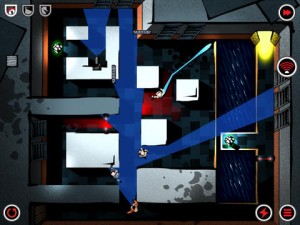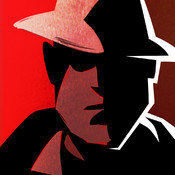You are Rothko, a man with the ability to read other people’s minds, a unique gift which you have chosen to employ in a not so noble manner: by using it to steal priceless artifacts from museums. So goes the premise to Third Eye Crime (out now, $2.99), a noir themed game of espionage — and covert evasions — from the independent band of developers over at Moonshot Games. What looks like it should be an amazing game in theory, is unfortunately marred by quite a few issues — both control based, and otherwise — that I will be covering in extensive detail all too soon (but first the game play mechanics).
 You move Rothko around each location — which is viewed from a top down perspective — by drawing a path across the area, much the same way you navigated through the mazes in Little Labyrinths. Rothko will then exactly follow the path you’ve drawn — without any stops — until he reaches the end of the line you’ve drawn, although there is a significant difference here over how Little Labyrinths operated. Where as Little Labyrinths had a grid based movement system — wherein it didn’t matter how straight your line was, so long as you stayed within the walls — Third Eye Crime allows for far less rigid movement.
You move Rothko around each location — which is viewed from a top down perspective — by drawing a path across the area, much the same way you navigated through the mazes in Little Labyrinths. Rothko will then exactly follow the path you’ve drawn — without any stops — until he reaches the end of the line you’ve drawn, although there is a significant difference here over how Little Labyrinths operated. Where as Little Labyrinths had a grid based movement system — wherein it didn’t matter how straight your line was, so long as you stayed within the walls — Third Eye Crime allows for far less rigid movement.
It will be — using this singular, yet not necessarily simple, input method — your job to direct Rothko to each stage’s exit, while ideally picking up each and every extra treasure available along the way. Attempting to stop Rothko will be various guards — some with weapons, and some without — all of whom will begin chasing and/or firing at the player the moment they see him, as well as various sensor alarms that can be activated as well. Furthermore — as per standard mobile traditions — there will be three specific optional challenge goals per stage, with the player only receiving a full three-star rating if all of them are simultaneously accomplished within a single run.
The first problem with this premise is the fact that a common stage challenge is to finish the stage within a specific target time, which can generally only be accomplished by going from start-to-finish through the level via a perfectly rendered singular line. Although such a task might have been easy to accomplish had this game’s name been Little Labyrinths, in Third Eye Crime your speed through a stage can often be deleteriously thrown a second off if you didn’t draw all of your line in a perfect manner. It once took me a large number of tries to get a specific level’s three-star rating simply because my path — which was basically the same every single time — was ever so slightly imperfect each time I drew it with my finger, yet this was not the worst problem present.
 The chief mechanic that is intended to help Rothko on his mission would be his ability to tell what his opponents are thinking, which is displayed in game as the area of the map where they think you might be hiding being lit up bright red. In theory this is supposed to help you by informing Rothko of which spots are destined to be searched next, but in practice this information generally has a very minimal outcome upon your actual results. In reality your success will have far more to do with how well you’ve learned the logic behind the game’s AI search algorithms, rather than anything involving which areas are currently painted red.
The chief mechanic that is intended to help Rothko on his mission would be his ability to tell what his opponents are thinking, which is displayed in game as the area of the map where they think you might be hiding being lit up bright red. In theory this is supposed to help you by informing Rothko of which spots are destined to be searched next, but in practice this information generally has a very minimal outcome upon your actual results. In reality your success will have far more to do with how well you’ve learned the logic behind the game’s AI search algorithms, rather than anything involving which areas are currently painted red.
The first major problem is that enemies have a very nasty — although perhaps realistic — habit of looking all over the place as they walk towards their objective, meaning most non red spots aren’t exactly safe from the enemies’ constantly sweeping cones of vision. The only way to counter this is perfect rote memorization of how an enemy will behave given specific inputs, knowledge which will sadly be worthless if they ever accidentally — thanks to the game’s imperfect path drawing methods — see you while turning a corner. The end result is that you basically should straight up ignore which areas are currently colored red, since the info — without knowledge of where the enemies plan to look along the way — might as well just be getting in the way.
Now lets pretend for a moment that the red light info wasn’t utterly worthless, wherein the game’s enemies lacked eyes that glanced all over the place as they walked about, then it would still ultimately become worthless a few stages into Third Eye Crime all the same. Unfortunately — the exact moment additional foes show up — you are presented with a grand dilemma, for you suddenly have a screen that quickly becomes lit up red all over without any hint as to which enemy is planning to go where. So now — even if the game didn’t come with ADHD vision action — you still are utterly incapable of knowing which black areas are safe, as you don’t know which enemy is targeting each of the red areas.
 In the end you have a game that — had the telepathy conceit been entirely removed — would be virtually the exact same experience, other than the fact that Rothko needs to have it for the stylish between region cut scenes to make any sense. Although Rothko does eventually get access to gadgets that help him out, such as noise makers that can sort of make enemies search where he wants them to, they do little to save the game play. Finally, I should point out that — although a certain amount of these are provided by default on specific levels — the developers will furthermore sell extra items to players via IAP means (perhaps because the developers realize just how worthless Rothko’s ESP is).
In the end you have a game that — had the telepathy conceit been entirely removed — would be virtually the exact same experience, other than the fact that Rothko needs to have it for the stylish between region cut scenes to make any sense. Although Rothko does eventually get access to gadgets that help him out, such as noise makers that can sort of make enemies search where he wants them to, they do little to save the game play. Finally, I should point out that — although a certain amount of these are provided by default on specific levels — the developers will furthermore sell extra items to players via IAP means (perhaps because the developers realize just how worthless Rothko’s ESP is).
Which finally leaves us with the only thing that Third Eye Crime almost managed to have going for it: the game’s noir prose and stylish graphical flair, both of which are certainly impressive during the game’s between region cut scenes. The problem with the graphics — outside of the static cut scenes — is that they’re animated rather oddly in the game, making everyone — hero included — move around with the grace of a drunken shambling zombie. Furthermore — assuming you were enjoying the plot — you should be aware that you’ll very quickly hit the end of game’s first act, after which you’ll be required to buy extra chapters as IAP based expansion packs (meaning that $2.99 was just for the demo).
In the end — between a gimmick that doesn’t help, imprecise controls that will often harm your efforts, very little content before you’re expected to pay for more stages, and some very awkward game play animations — it’s rather hard to recommend Third Eye Crime.
iFanzine Verdict: Although having a rather unique concept in theory, the noir tale of a thief who eludes his pursuers by knowing where they plan to go next, Moonshot Games’ Third Eye Crime unfortunately comes short on matters of execution. Rothko’s ability to see where his enemies plan to go — represented by the floor turning red — unfortunately doesn’t take into account either their extremely wandering vision, or whom specifically is intending to go where when multiple enemies are present. Couple this with controls that are only as precise as your ability to draw perfectly straight lines, and speed challenges where your performance can’t even be one second below perfection, and the end result is that Third Eye Crime is not very fun to play. This is then exacerbated by the fact that the initial $2.99 admittance fee is merely to permit you to look at a demo of the entire package, with you being required to buy the rest of the game — awkward animations and all — via additional in game purchases.


